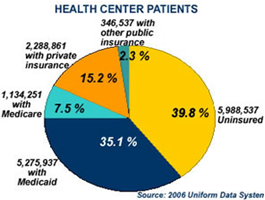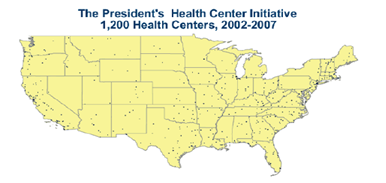
 |
|
|

|
Targeting Human NeedsCommunity Health Services
|
|||||||||||||||||||||||||||||||||||||||||||||||||||||||||||
|
Compassion Spotlight
|
|
The Need
The Response
President’s Health Centers Initiative
In 2002, President Bush launched the President’s Community Health Center Initiative (CHCI) and pledged to create 1,200 new or expanded Health Center sites in the country’s most underserved communities to increase access to health care.
 |
These Health Centers are community-based and consumer-run organizations that serve populations with limited access to health care. Often, they are operated by FBCOs located in the neighborhoods they serve and governed by local residents. Within this community context, Health Centers offer personalized interaction and compassionate care to every patient. In addition to providing primary care, Health Centers may provide access to pharmacy, preventive dental, mental health, prenatal care, and substance abuse services.
Through the CHCI, Federal investment in the Health Centers has nearly doubled—from slightly more than $1 billion in FY 2000 to nearly $2 billion in 2008. The CHCI strategy focuses on
|
 |
In FY 2007, the President announced that the CHCI exceeded the goals he set in 2000. To date, there are more than 7,000 Health Center sites across the country helping Americans most in need. The primary beneficiaries of Community Health Centers include low-income individuals (91% of patients) and minorities (64% of patients).
The presence of over 1,200 new or expanded Health Centers translates into vast increases in the number of previously underserved Americans receiving health care:
President’s Health Centers Initiative
| Number of Community Health Grants Awarded, by Activity and Fiscal Year (FY) | |||||||
|
FY 2002 |
FY 2003 |
FY 2004 |
FY 2005 |
FY 2006 |
FY 2007 |
Total |
New Access Points |
171 |
100 |
63 |
94 |
86 |
202* |
716 |
Expanded Medical |
131 |
88 |
66 |
64 |
36 |
135 |
520 |
Total |
302 |
188 |
129 |
158 |
122 |
337 |
1,236 |
| * Included are up to 80 grants for the High Poverty Counties Initiative. | |||||||
Exemplary Impact
Christ Community Health Services is an example of how a new CHCI partner impacted the surrounding community. Memphis, Tennessee, has distressingly high rates of infant mortality, adult chronic disease, and avoidable deaths. From its founding in 1995 until 2003, Christ Community Health Services was a financially struggling community-based organization. It was often unable to recruit physicians and staff to the distressed neighborhood where it is located, which had no other health resources.

Sites where Community Health Centers were either established or expanded
For more information about the work of Christ Community Health Services, visit http://www.christcommunityhealth.org/home.htm ![]()